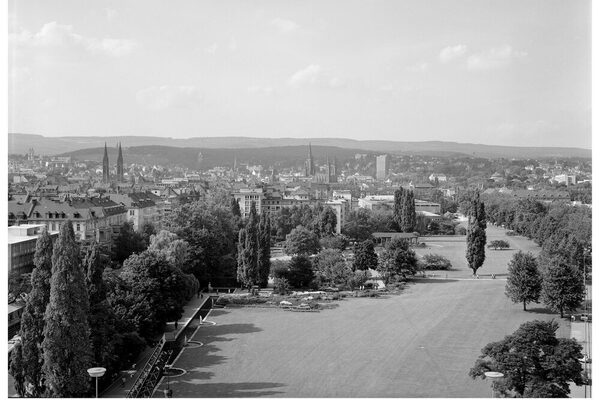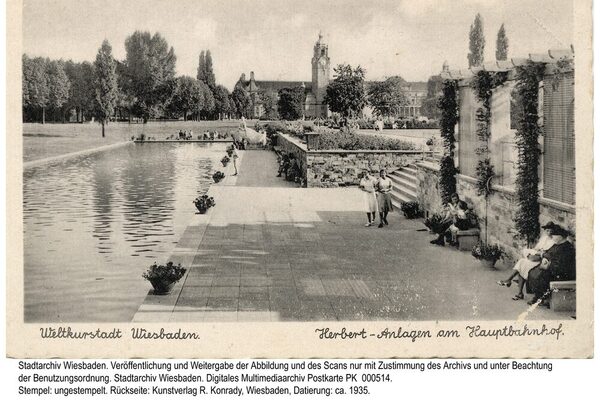Reisinger facilities (formerly Reisinger and Herbert facilities)
The Reisinger grounds opposite the main railway station (opens in a new tab) owe their existence to the generous donations of the merchant Hugo Reisinger (opens in a new tab) and the pharmacist Adam Herbert (opens in a new tab). A gas factory as well as the Taunusbahnhof, Rheinbahnhof and Hessische Ludwigsbahnhof were located on the site or in the immediate vicinity.
After the construction of the main railway station, these buildings were demolished and the area became an industrial wasteland. When Reisinger donated $25,000 to the city for a fountain in 1913, various locations were initially considered, but the terrain of the former Salzbachtal was then considered. Implementation was delayed by the First World War (opens in a new tab) and was only resumed at the end of the 1920s.
The garden architect Friedrich Wilhelm Hirsch, the architect Edmund Fabry and the sculptor Arnold Hensler emerged victorious from a competition in 1931. The most important goal was to uncover the site. In addition, a fountain was to be created, which was to symbolize the healing springs in the form of jumping jets coming "as it were from the bottom of the meadow". A canal running alongside the main path ends at a water basin with a kneeling marble sculpture of a spring nymph by Hensler. The complex was opened to the public in 1932.
The remaining areas were used for sports fields and allotments. In 1936, the decision was made to use the funds donated by the pharmacist Herbert to extend the Reisinger grounds. Friedrich Hirsch was again responsible for the design of the park, while the architect Ernst von den Velden created a pillared hall and the Stuttgart sculptor Ludwig Spiegel the monumental shell limestone sculpture of Europa on the Bull. The design of the garden complex with its pseudo-antique Wandelhalle makes reference to National Socialism. The 1.5-ton shell limestone sculpture in particular picks up on typical stylistic elements of Nazi design aesthetics. The iconography of the former Herbert complex thus also served to represent the propagated sense of community in the local Nazi "people's community". In its design, the reception by National Socialism is already recognizable, in which the deliberately flat, static illustration style in combination with the sgraffiti technique is intended to underline the solid craftsmanship of this monumental architectural painting. The "Europa-Anlage" - or Herbert-Anlage - with its sweeping "European program" is an iconographic exception in Germany. It was created in the year when the first official "Europa" depictions of German fascism appeared.
The new complex with its Wandelhalle and large water area was inaugurated on July 6, 1937. A speech was given by the donor, Adam Herbert, and NSDAP mayor Erich Mix, who had invited guests to the event. The program was framed by the spa orchestra. The most important municipal representatives were present, as were high-ranking representatives of the NSDAP, the SS, the SA, the NSKK, the Hitler Youth and the BDM.
After the Second World War (opens in a new tab), the American troops used the area as a parking lot. The restoration of the park began in 1950. Adam Herbert provided further funds for the creation of the Diana Fountain in front of the Rhein-Main-Hallen (opens in a new tab).
Today, the park is used as a sunbathing and play area and for open-air events. In the course of the construction of an adjacent kindergarten and the Rhein-Main-Hallen, contaminated sites were remediated by removing the remains of the gasworks from the ground and restoring the historic green area of around 3.4 hectares to its original state.
The Historical Expert Commission appointed by the City Council in 2020 to review traffic areas, buildings and facilities named after people in the state capital of Wiesbaden recommended renaming the Herbert-Anlage because of Adam Herbert's proximity to the Nazi regime. The Wiesbaden-Mitte local council followed the recommendation and decided on February 1, 2024 that the term "Herbert-Anlage" could be dropped. The local council asked the magistrate to merge the Herbert-Anlage into the Reisinger-Anlage to the south. The donor plaque should be contextualized.
[[This text was created in 2012 by Martina Clair Michel for the printed version of the Wiesbaden city lexicon and revised and supplemented by Dr. Katherine Lukat in 2024]].
Literature
Franke, Nils M.: Expert opinion on the historical development of the Herbert-Reisinger-Anlagen Wiesbaden, contribution to the park maintenance work, Wiesbaden 2007.
Sigrid Russ, editor, Denkmaltopographie Bundesrepublik Deutschland. Cultural monuments in Hesse. Wiesbaden I.2 - City extensions within the ring road. Ed.: State Office for Monument Preservation Hesse, Stuttgart 2005 [p. 150 ff.].
Names in public spaces. Final report of the historical expert commission for the examination of traffic areas, buildings and facilities named after people in the state capital Wiesbaden, in: Schriftenreihe des Stadtarchivs Wiesbaden, Vol. 17. Wiesbaden 2023.

